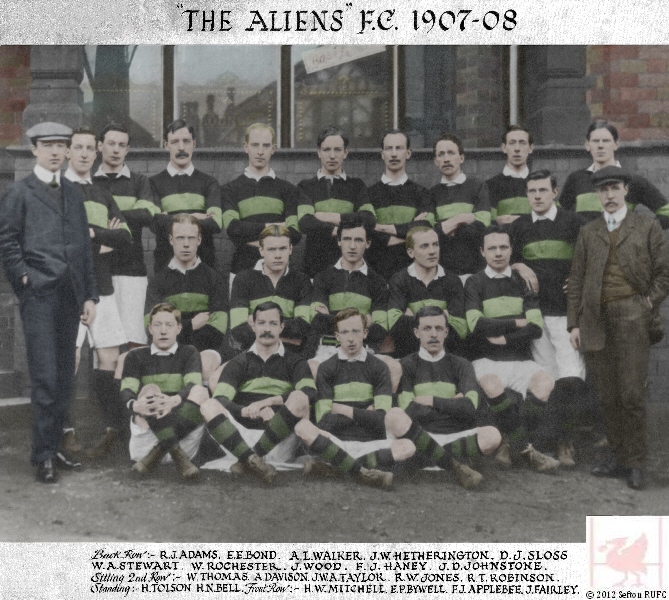
An Alien at War
James William Archibald Taylor
Written and researched by David Bohl, with the kind help and documents supplied by Dr Colm Hickey, Director of Education at John Paul 2 Foundation 4 Sport, and World War 1 historians world wide.
Born in Liverpool, 1883 James Taylor attended Borough Road College, London from 1902-04 gaining a Inter B.Sc and taught in Liverpool at Arnot Street School, off County Road in Walton. He was a founder member and the first Captain of The Alien5 Rugby Union Club based at Clubmoor becoming President in 1926-28. He lived at 9 Sybil Road, Walton also 3 Tilney Street, Orrel Park and married in 1915 to a Ms Story.
(Colours were black with an emerald hoop)
ECCLES WIN BY A POINT.
The Aliens of Liverpool have developed quite a strong side, and Eccles only beat them by two tries (six points) to one goal (five points). The same, however, lasted only 35 minutes, for at half time the captains and referee decided that the condition of the ground had become so bad as to render further play dangerous. What play there was, however, was exhilarating, and although there was much bone in the ground there was some vigorous tackling. The Alien5 have a pack much weightier than Eccles, but owing to the hard state of the ground they were unable to get a foothold for the push in the scrummages. In the scrummages Eccles got the advantage by smarter heeling out. In the loose they were quite as good as Eccles, and one player, R. A. O'Donnell, formerly of Cork Constitution was very prominent. There were some good passing runs, and the game had not been in progress more than ten minute's when the Aliens backs indulged in one of the cleverest moves that has been seen on the Eccles ground. Eccles forced a scrummage near thc Aliens' line, and the ball corning out to the A1iens' scrummage half he ran round to J. H. Helme, who gave the inside pass to W. B. Croxford. Croxford received the ball near his own "25," and, after a race three-quarters the length of the field, scored a try between the posts. H. N. Ellis converted. Some good work in a loose dribble by H. Bowker, J. Bolton, and W. T. Pearson forced the ball over the Aliens' line, and T. Whitehead dashed up and scored. Shortly afterwards Eccles took the lead by a clever move by E. Kendal, who received the ball from a scrummage and punted across to F. L. H. Oakley, who took the catch while at full speed and scored a try at the corner. The remaining play fluctuated considerably, and it is to the credit of the two full backs, W.H. Eidsforth (Eccles) and J. W. A. Taylor (Aliens) that there was no further scoring. Both of them, considering the hard nature of the ground, tackled in very daring fashion, and their kicking was clean.
Manchester Guardian 2/12/1912
Resigns From Club 1913
Committee Meeting held at Townsend Lane Schools September 6th 1913
Present Messrs Knipe, Applebee, O.E.Bayliss, Croxford, Milbourn, H.Bayliss, Haney, Williams, Ellis
The minutes of the previous meeting were taken "as read".
The following members were elected as selection committee
Messrs Helme, Knipe, Williams, Jones with captains, sub-captains and secretary.
The following resignations were accepted.
W.Johnston, J.W.A.Taylor, H.W.Thomas
Territorial Force WW1
Taylor joined the ranks of 10th Battalion Liverpool Scottish in September 1914 before taking part in the British Expeditionary Force to France with 'Q' Company, Special Brigade of the Royal Corps of Engineers. To staff the gas ‘Special Companies' (later, Special Brigade) chemistry teachers and students were recruited from universities and colleges. The numbers were bolstered by a draft of infantrymen trained in chemistry.
Special Brigade, 8.9.1915
2Lt Royal Engineers, 12.05.1916
Lt Royal Engineers, 12.11.1917
Wounded at duty - 29.6.1916 and
29.6.1918
To England (sick) 28.10.1916
Rejoined unit 22.2.1917.
Demobilized, 17.2.1919.
The activities of Q Company can be found at the National Archives in WO
95/122 and WO 95/402.
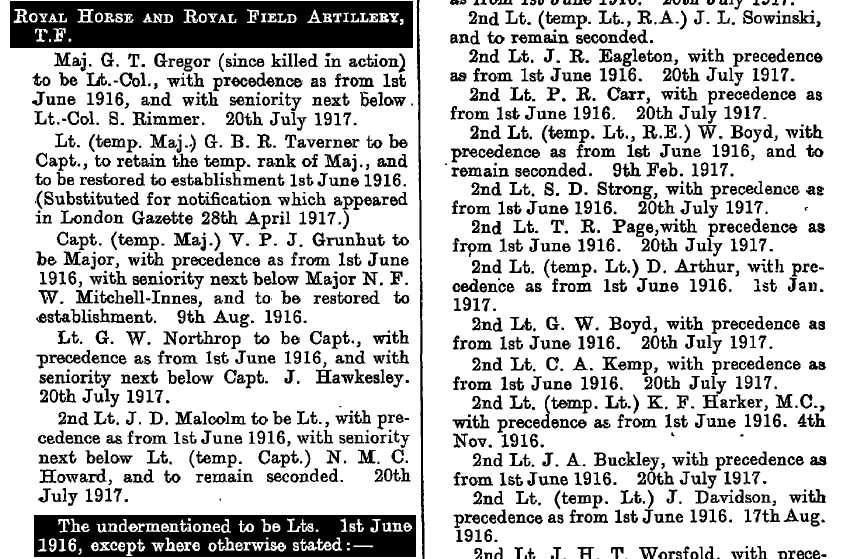
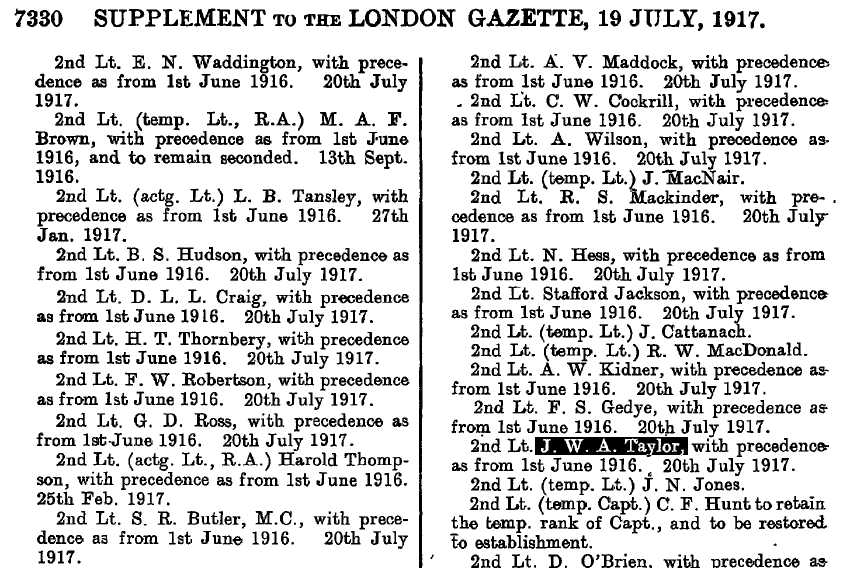
The Special Companies RE (Narrative - The Long, Long Trail www.1914-1918.net)
The Special Companies at the start of the war
No Special Companies existed in 1914. They were a war time invention. The Great War was the first in which chemical weapons were deployed. There was great moral shock and outrage at the first use of Chlorine, released by the Germans against defenceless French troops in the Ypres Salient. The Special Companies of the Royal Engineers were formed to develop the British response. By 1918, gas was used both offensively and defensively, delivered by a range of sophisticated techniques.
The first use of poison gas, 22 April 1915
A bulletin issued by the French
Tenth Army on 30 March 1915
noted
that the German XV Corps in the neighbourhood of Zillebeke (near Ypres)
had installed iron cylinders containing an asphyxiating gas into their
front-line trenches. A German prisoner taken near Langemark on 14 April
told of a forthcoming gas attack on the French units in that sector,
arranged for noon on 13 April but delayed while waiting for a
favourable wind. The man carried a small sack filled with cotton waste,
which would be dipped in some chemical solution to counteract the
effect of the gas. A Belgian agent reported much the same thing. A
reconnaissance flight by No 6 Squadron of the Royal Flying Corps
reported nothing unusual in the German positions. Further information
from Belgian sources on 16 April 1915 reported the manufacture in Ghent
of 20,000 face masks.
Despite these warning signs, no specific defensive steps were taken:
the concept of large concentrations of a poison gas was unfamiliar, and
barely believable from a practical or moral viewpoint. It was
specifically banned by the Hague Convention of 1907.
The Germans attacked using a cloud of Chlorine gas, a bluish-white mist
rolling forward on the wind, on 22 April 1915 near Langemarck. The
subsequent fighting, with both sides rushing reinforcement into the
area, developed as the Second Battle of Ypres.
Chlorine has a powerful irritant action on the lungs and mucous
membranes; prolonged exposure is fatal. Men who stayed in position,
especially on the firestep of the trenches, suffered least as the cloud
rolled past them. Terrified men who ran with it, and the wounded lying
on the ground or in trench bottoms, got the worst exposure. The Germans
released 180 tonnes of gas, in a flow which lasted for 5 minutes..
French and British reaction
Allied reaction was one of outrage and much propaganda capital was made of the German use of gas; but by mid-May 1915, after gas had been used again in the Ypres Salient on several more occasions, both French and British defences were already in place. The first batch of gas helmets (flannel bags with talc eye-pieces), enough to issue 16 to each infantry battalion, were provided for machine-gunners. Men already knew by then that a piece of gauze or cotton wadding, soaked in urine, provided a crude protection. Vermoral sprayers were issued, to neutralise any gas that hung in the trenches. With modification, these measures carried on throughout the war; 'gas gongs' (usually an empty shell-case) were located in most front-line trenches as an immediate signal of any presence of gas to unwary troops.
The first Special Companies are formed
As early as 3 May 1915 the
British Secretary of State for War,
Lord
Kitchener, authorised the preparation of measures to retaliate against
the German use of poison gas. Experimental research work was carried
out at Porton, and a laboratory established at Helfaut, near St Omer in
France. The Kestner-Kellner Alkali Company, being the only firm in
Britain capable of manufacturing Chlorine gases in quantity, supervised
trials with the final large-scale one taking place at Runcorn on 4
June. The method - as used by the Germans - was to form a continuous
cloud by discharging compressed gas from cylinders to the atmosphere,
and allowing the wind to move it over the enemy positions.
Special Companies of technically skilled men, under Major C.H. Foulkes
of the Royal Engineers, were formed with a Depot at Helfaut, to deal
with the new weapon. Nos 186
and 187 Special Companies
were formed first, in July 1915, followed by 188
and 189
Companies
in August. All of the men were given the rank of Chemist Corporal. On 4
September 1915 the first two Companies, totalling 34 Sections of 28
men, were assigned to First Army for forthcoming operations.
The British decide to use gas in the attack at Loos, 25 September 1915
The British army employed poison gas for the first time in the opening barrage for the Battle of Loos, principally to overcome a shortage of artillery. All ranks were issued with the original pattern gas helmets, but the battle and weather conditions at Loos proved them to be a severe hindrance (the eye-pieces prohibited vision and movement; rain caused chemicals in the fabric to run out and irritate the eyes, and breathing was difficult). Many men chose to discard the helmet.
Both sides develop gas as an offensive weapon
Significant advances in the
production of gas were made after
Loos
by the Chemical Department of the Ministry of Munitions. Carbonyl
Chloride - or Phosgene - had already been identified as a suitable
cloud gas. It was similar to Chlorine yet could be inhaled for a
considerable time without being noticed, only to produce serious or
fatal inflammation of the lungs. (The Germans were the first to release
Phosgene, in an attack at Ypres on 19 December 1915). The Allies
decided to employ a Phosgene-Chlorine mixture, codenaming it 'White
Star'.
In June 1915, British Commander-in-Chief Sir John French requested that
10% of all4.5-inch, 60-pounder and 12-inch shell production should
contain gas, in response to increased German use of lacrymatory (tear)
gas shells. The first trial SK (South Kensington, codename for Ethyl
Idoacetate) shells arrived in September 1915, but it was not until
April 1916 that 10,000 rounds had arrived, giving a small battlefield
supply. By the end of 1916, only 160,000 rounds had been delivered and
it was not until large quantities of Phosgene shell became available in
1917 that the Army was adequately equipped.
In the 1916 Battles of the Somme, the British army released 1,120 tons
of gas, mostly White Star, in 98 separate attacks. Very little gas
shell was used, all of which was fired by French artillery.
Defensive measures are also developed
The P (Phenate) gas helmet with glass eyepieces was introduced in November 1915. It did not protect adequately against Phosgene, and was replaced by the PH (Phenate-Hexamine) helmet from January 1916. From August 1916, the PH was replaced by the small box respirator, which although an unwieldy design gave protection against the different gases in use.
The Special Brigade is formed
Despite the limited results achieved by the cloud gas discharge at Loos, it was believed sufficiently successful to warrant further development. One of the first acts of Sir Douglas Haig on his appointment as Commander-in-Chief was to request that the War Office expand the four Special Companies of the RE into a more substantial force, viz.
This request was approved and
the Brigade built up by adding
volunteers from units already in France to the four original Companies.
Later, drafts from England would join. The force was designated the Special
Brigade.
It was placed under the command of Col. C.Foulkes, RE, who was
appointed Assistant Director of Gas Services; he reported to
Brigadier-General H.Thuillier, RE, Director of Gas Services. Lt-Col.
S.Cummins, RAMC acted as Director of Anti-Gas Measures.
By the end of May 1916, No 1 Special Battalion and No 2 (less a Company) were allocated to Fourth Army; No 3 (less a Company) to Second Army; No 4 (also less a Company) to Third Army. No 4A Battalion was provisionally formed from the three detached Companies, and was attached to First Army. No 5 Battalion was the Stokes mortar unit, and had 3 Companies attached to Fourth Army and 1 to Third Army. The Flame Projector Sections arrived in France 26 June 1916.
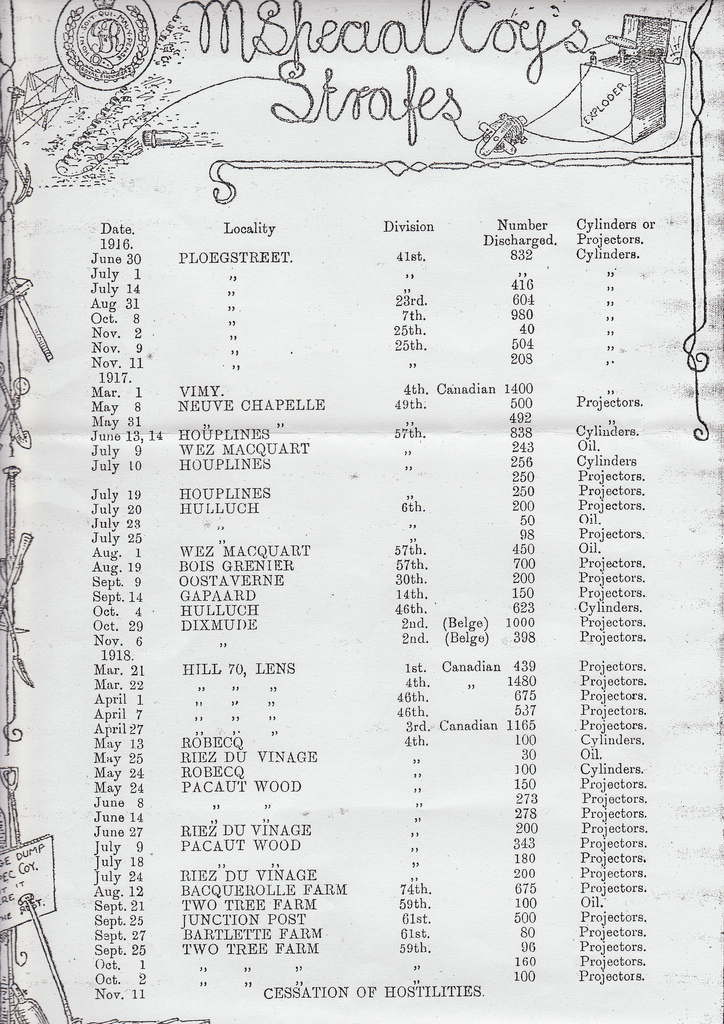
(Image from http://www.westernfrontassociation.com)
Military Cross Citation 1919 and Commission Relinquished 1921
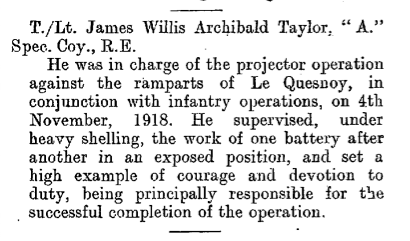
London Gazette - Incorrectly say "Willis", but Regiment correct.
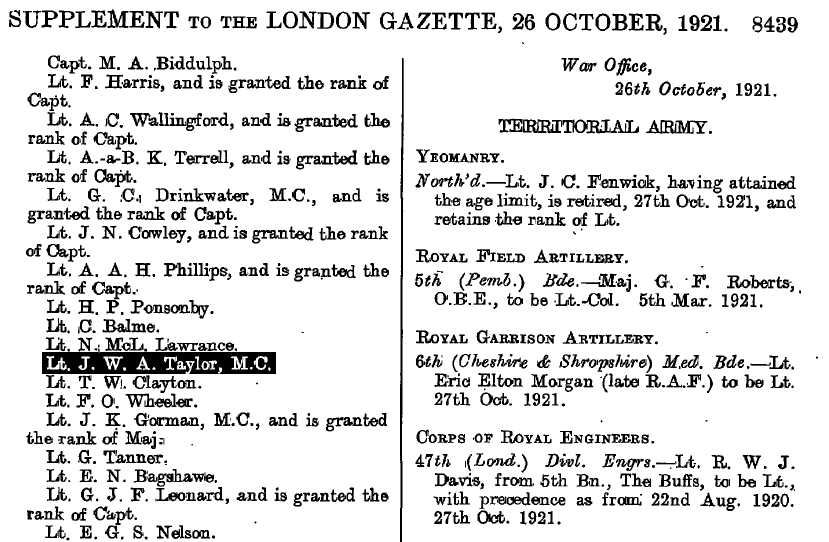
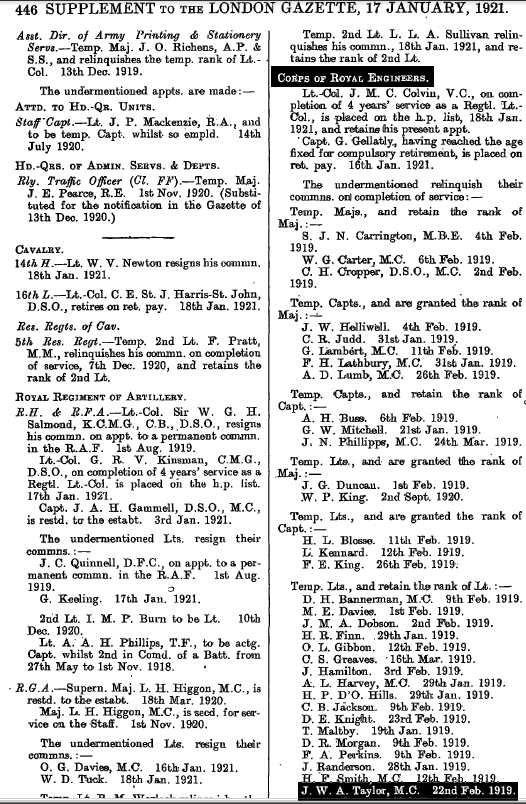
Reform of The Aliens 1st April 1919
General Meeting held at 'The Bee Hotel' 1.4.19
Present Messrs R.W.Jones, Applebee, Helme, Milbourn, S.J.Kay, Reid, Upward, Croxford, Marshall, O'Donnell, Outhwaite, R.A.Roberts, H.N.Ellis, J.R.Williams
Minutes of previous general meeting were read and confirmed.
The meeting decided that an effort should be made to continue the club, the secretary being asked to make arrangements for ground for coming season and to arrange a list of fixtures for first and second teams, on the proposition of H.N.Ellis, seconded by Mr S.J.Kay.
Elected a Vice-President
General Meeting held at 'The Bee Hotel' 3.10.19
Present Messrs Croxford, Marshall, Thomas(S.R), Owen, Bellamy, Kay, Ellis, Helme, D.Sloss, Taylor, Milbourn, Knipe, Outhwaite, J.R.Williams, Upward
Mr Knipe was appointed chairman.
Minutes of previous general meeting were read and confirmed.
The 'ground committee' reported failure to obtain a suitable ground.
Mr Croxford proposed and Mr Helme seconded 'That the season be started with one team, and whenever possible all matches be played 'away' until such time as a ground be obtained.' Carried
The Election of Officers resulted as follows
President. Mr J.G.Legge
Vice Presidents Messrs Croxford, Flenley, Johnstone, R.W.Jones, J.Kay, Knipe, Kearns, R.Madoc-Jones, Morgan, Milbourn, Nicholas, Raus, W.R.Smith, Stringer, Waldron, I.R.Williams, Fox, Marshall, Taylor and Harding
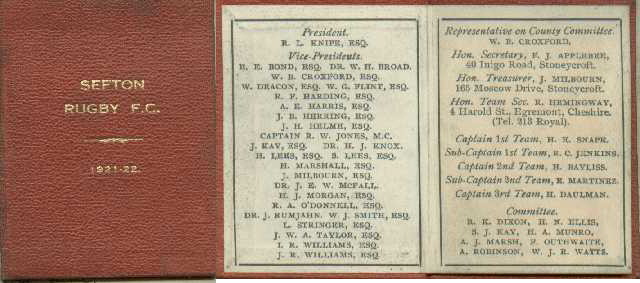
1921/22 Handbook
Only death record is:-
TAYLOR James W A England Westmorland, Westmorland North 1953
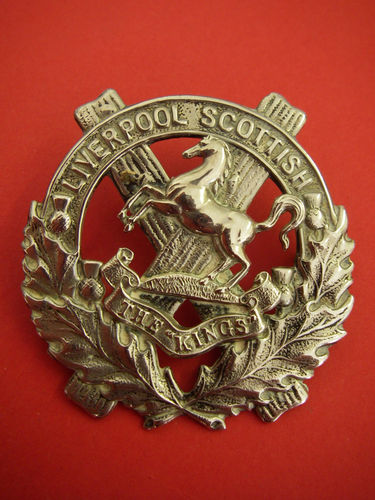 |
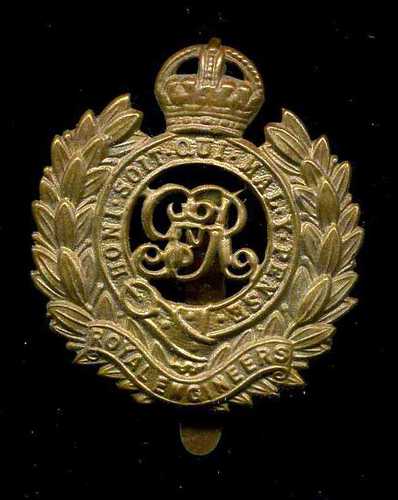 |
|
Cap
Badge - The
King's Liverpool Scottish
|
Cap
Badge - The
Royal Corps of Engineers
|
|
|
|
Lt J.W.A Taylor MC
(1883-1953)
All Aliens RFC, Seft0n RUFC photographs, programmes and memorabilia Copyright © 2012 Sefton RUFC